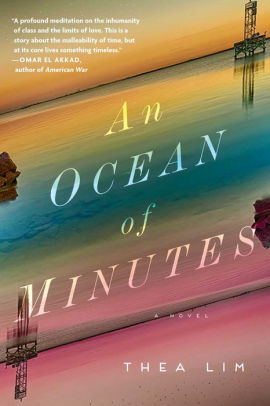A Review of Thea Lim’s An Ocean of Minutes (Touchstone, 2018).
by Stephen Hong Sohn
One of the standout Asian North American literary debuts ever! Thea Lim’s An Ocean of Minutes (Touchstone, 2018) is a speculative fiction that is told primarily from the perspective of Polly Nader, a young 20-something. It is 1981. We’ll let B&N take it from here:
“America is in the grip of a deadly flu pandemic. When Frank catches the virus, his girlfriend Polly will do whatever it takes to save him, even if it means risking everything. She agrees to a radical plan—time travel has been invented in the future to thwart the virus. If she signs up for a one-way-trip into the future to work as a bonded laborer, the company will pay for the life-saving treatment Frank needs. Polly promises to meet Frank again in Galveston, Texas, where she will arrive in twelve years. But when Polly is re-routed an extra five years into the future, Frank is nowhere to be found. Alone in a changed and divided America, with no status and no money, Polly must navigate a new life and find a way to locate Frank, to discover if he is alive, and if their love has endured. An Ocean of Minutes is a gorgeous and heartbreaking story about the endurance and complexity of human relationships and the cost of holding onto the past—and the price of letting it go.”
Going to the future is about dealing with the crisis of the flu. In exchange for Polly’s time jump and a contract of labor that she will finish off in that future timeline, Frank will receive medical care in his non-obstructed timeline. The catch is that Polly and Frank will have to plan on how they will rendezvous with each other in that future. What Polly and Frank don’t know is that the future temporality comes with new nation-state boundaries. The United States is basically split in half, with the southern half being called America. Polly arrives to a future in which she’s forced to work in the American section in a contract labor situation that only gets worse and worse. This section of the novel I found difficult to get through because so many of the characters that Polly meets are despicable. I began wondering if I had the fortitude to finish the narrative because characters that even at first seemed to be more genuine ended up having ulterior motives. Eventually Polly’s status—she came on something called an O-1 visa, which is of a higher time traveling designation—is downgraded to an H-1. She is accused of a kind of theft, which extends her contract labor and causes her to do more menial tasks. At the same time, she discovers that Frank has not been able to meet her at the designated rendezvous point, likely in part due to the nation-state boundary restrictions generated within the last 17 years. All hope seems to be lost; Polly slowly begins to create a new life in America, but another chance circumstance allows her to reduce her contract labor time, while potentially finding a way to get more information about what happened to Frank. The novel has to use temporal intercuts in order to generate more pathos concerning Polly and Frank’s relationship. As I was thinking back on Lim’s choice, I realized that she had to include these sections, otherwise we wouldn’t quite understand why Polly was so invested in Frank and what it meant to her to be reunited with him. The purity of that young love is what constitutes her drive, her desire to survive her circumstances, and her persistence in believing that there might be a chance for a reunion. The back third of the novel, I thought, was the strongest. Finally, we get a sense of what Lim is doing with the romance plot, and the payoff is ultimately one of the most unsentimental, yet affecting endings I’ve read in quite a long time. The interesting thing about this novel is that the world building suggests such a complicated political quagmire, but only the surface is really engaged. This issue is something I’ve been thinking about a lot, especially because the limitations of the romance plot, with its explicit focus on two lives, does not necessarily allow for a more expansive perspective that perhaps would have been more fitting for the scale suggested by the speculative elements. The other dilemma that Lim brings up is the mechanics and functionalities of time travel; quite a bit is simply left unexplained, which didn’t bother me so much, only insofar as the novel moves in a different direction, leaving behind time travel for the most part. Yet, I still wondered more about how the time travel was invented and to what ends it has been used. There are glimmers that scientists had been using time travel to deal with the flu epidemic, but these attempts were unsuccessful. In any case, still, the ending is absolutely worth the depressing sludge that is the first 2/3 of the novel.
Buy the Book Here!
Review Author: Stephen Hong Sohn
Review Editor: Xiomara Forbez
If you have any questions or want us to consider your book for review, please don't hesitate to contact us via email!
Prof. Stephen Hong Sohn at ssohnucr@gmail.com
Xiomara Forbez, PhD Candidate in Critical Dance Studies, at xforb001@ucr.edu